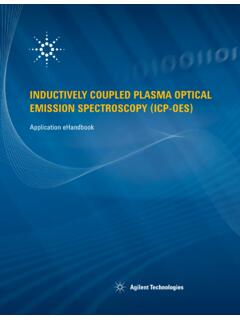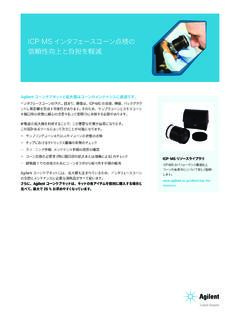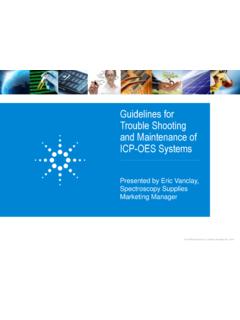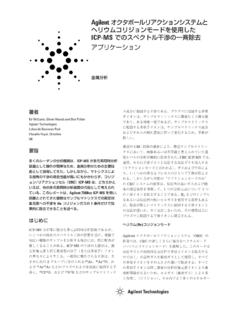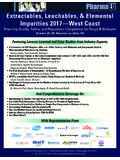Transcription of Agilent 8900 Triple Quadrupole ICP-MS - hpst.cz
1 Introduction Agilent is the worldwide market leader in Quadrupole ICP-MS , and the only supplier of Triple Quadrupole ICP-MS (ICP-QQQ). Introduced in 2012, ICP-QQQ has transformed interference removal in ICP-MS , using MS/MS to control reaction chemistry and deliver consistent, reliable results in reaction mode. The Agilent 8900 ICP-QQQ builds on the success of the Agilent 8800 ICP-QQQ, with enhanced performance to improve the ultra-trace measurement of difficult analytes, coupled with ease of use and productivity tools to enable a wider range of applications to be 8900 Triple Quadrupole ICP-MSTechnical Overview 2 Interference control in Quadrupole ICP-MS and ICP-QQQ Agilent s 7800 and 7900 Quadrupole ICP-MS instruments offer market-leading collision reaction cell (CRC) performance for controlling polyatomic interferences using helium (He) collision mode.
2 This performance advantage is a key reason why Agilent is the worldwide market leader in Quadrupole ICP-MS (ICP-QMS). Agilent s He mode reduces common matrix-based polyatomic ions, improving accuracy for typical analytes in common sample types. But some analytes, sample types and interferences cannot be addressed adequately using collision mode. Examples include trace level measurement of elements such as silicon, phosphorus and sulfur, ultra-trace analysis of high purity materials and semiconductor process chemicals, and the resolution of doubly-charged and isobaric overlaps. In these cases, reactive cell gases may offer a superior approach to separating the interferences. However, reaction mode does not offer a reliable solution on conventional Quadrupole ICP-MS , because such instruments do not have a mass filter before the CRC.
3 This means that the ions that enter the cell will vary depending on the sample composition, so the reaction chemistry varies and therefore the measured ion/product ion spectrum is not measurement in mass-shift reaction mode: conventional ICP-QMS vs. ICP-QQQ Reaction gas (O2)40Ar40Ar+, 160Gd++, 160Dy++40Ar40Ar+,160Gd++,160Dy++40Ar40Ar +,160Gd++,160Dy++80Se+80Se+80Se+ 80Se160+80Se+ 80Se160+80Se160+80Se160+96Zr+,96Mo+,96Ru +96Zr+,96Mo+,96Ru+96Zr+, 96Mo+, 96Ru+96Zr+, 96Mo+, 96Ru+No Q1 - all ions enter the cellQ1 (m/z 80) rejects all ions apart from m/z 80Q2 (m/z 96) rejects all ions apart from m/z 96 Quad (m/z 96) allows through all ions at m/z 96 Figure 1B: ICP-QQQ. Q1 allows only ions at m/z 80 to pass to the cell all other ions are rejected.
4 80Se+ is converted to 80Se16O+ in the cell with O2 reaction gas. Q2 measures SeO+ at m/z 96. Zr, Mo and Ru cannot interfere since they were rejected by +, 160Gd++, 160Dy++Reaction gas (O2)Figure 1A: Conventional ICP-QMS. Using O2 reaction gas, Se is reacted away from interferences (Ar2+, Gd++ and Dy++) at m/z 80. 80Se+ is converted to 80Se16O+ in the cell and measured at m/z 96. However, Zr, Mo and Ru all overlap at m/z 96, leading to incorrect Se data3 The first Triple Quadrupole ICP-MSIn 2012, Agilent introduced the world s first Triple Quadrupole ICP-MS , the Agilent 8800 ICP-QQQ a break-through instrument that extended the performance capability and scope of ICP-MS . The tandem mass spectrometer (MS/MS) configuration of ICP-QQQ uses two Quadrupole mass filters, Q1 and Q2, separated by an Octopole Reaction System (ORS) outperforms conventional Quadrupole ICP-MS for established applications, and provides far superior control of interferences in reaction mode, due to the additional Quadrupole (Q1) positioned before the CRC.
5 This additional mass filter enables MS/MS operation, where both Q1 and Q2 are operated as unit mass filters; Q1 rejects non-target masses, so the ions that enter the cell are independent of the sample matrix composition. This means that ion-molecule reaction chemistry is predictable and consistent, so results are reliably accurate, and detection limits (DLs) are improved for challenging applications that require a reactive cell gas. The basic functional differences between ICP-QMS and ICP-QQQ are represented in Figures 1A and 1B, using the analysis of selenium as an selectivity of reaction chemistry enables ICP-QQQ to achieve some unique and remarkable performance capabilities. One example is the ability to use a reaction gas to separate direct isobaric overlaps, where isotopes of two different elements occur at the same mass, such as 204Hg/204Pb.
6 Many direct isobaric overlaps would require a mass resolution (M/ M) of several 100,000 to separate them, far beyond the capability of high-resolution sector field ICP-MS , which is limited to a maximum resolution of 10,000. MS/MS mode is also fundamental to the superior peak separation of the QQQ configuration. Abundance sensitivity (AS) is a measure of the contribution that an intense peak makes to the adjacent masses. A typical Quadrupole ICP-MS has an AS specification of 10-7, but ICP-QQQ has two quadrupoles, and the AS is the product of Q1 AS x Q2 AS, so theoretically could achieve an overall AS of 10-14. While this figure cannot be verified experimentally, as the sensitivity difference exceeds the dynamic range of the detector, ICP-QQQ has been shown to provide vastly superior peak separation in a range of applications including trace boron in organic solvents, ultra-trace manganese in iron and whole blood, and trace analysis of radio isotopes such as U-236 and a result of the range of unique performance capabilities demonstrated by the Agilent 8800, ICP-QQQ has been rapidly accepted and is now widely used in high-tech industries, research labs and for routine applications in various fields [1, 2, 3].
7 Second generation ICP-QQQA gilent s second generation Triple Quadrupole ICP-MS , the 8900, provides performance and productivity improvements compared to its predecessor. It offers increased matrix tolerance (up to 25% dissolved solids), higher sensitivity, lower backgrounds for S and Si, and more flexible cell gas options. The 8900 ICP-QQQ also has a new detector with fast Time Resolved Analysis (TRA) capability for single nanoparticle analysis, and a dynamic range of up to 11 orders of magnitude. The 8900 ICP-QQQ consists of a single, high-performance mainframe with one standard configuration and two application-specific configurations, to address the wide range of customer requirements from research to routine applications: Agilent 8900 Standard configuration provides higher performance than Quadrupole ICP-MS for typical applications in food, environmental, nanoparticle characterization, geological and clinical-research laboratories.
8 Agilent 8900 #100 Advanced Applications configuration suitable for materials analysis, life science, low level Si and S analysis, and research. This instrument offers higher sensitivity specification; improved cell performance; low Si and S background; wider dynamic range. Agilent 8900 #200 Semiconductor configuration includes inert sample introduction; Pt interface cones; highest sensitivity; lowest DLs and cool plasma capability providing the highest performance for high purity semiconductor The 8900 Advanced Applications and Semiconductor configurations use a new argon gas flow system which utilizes materials that minimize silicon and sulfur background. This enables a detection limit specification of 50 ppt to be achieved for both of these elements, which were previously difficult to measure at trace levels using ICP-MS .
9 Sensitivity is increased through a new interface vacuum stage, which improves ion transmission, increasing sensitivity by up to a factor of two compared to the 8800. A new, fourth generation, four channel ORS4 collision reaction cell increases flexibility by supporting a wider range of reaction gases. On the 8900 Advanced Applications and Semiconductor configurations, the ORS4 includes axial acceleration, which further enhances sensitivity by increasing the axial energy of slow-moving product ions and suppressing the formation of higher-order product advancements deliver improved performance for many applicationsThe Agilent 8900 ICP-QQQ builds on the success of the previous 8800 model, improving key performance capabilities and extending the range of applications that can be addressed.
10 Drawing on the experience of several hundred 8800 users, and taking account of emerging and developing application requirements, the 8900 introduces new hardware and software developments to enhance performance for a wider range of applications: Ultra high matrix introduction (UHMI) capability on the 8900 Standard and Advanced Applications configurations. UHMI uses Agilent s proprietary aerosol dilution technique to extend matrix tolerance up to 25% total dissolved solids (TDS), matching the market-leading robustness of Agilent s Quadrupole ICP-MS 2. Schematic showing key hardware components of the Agilent 8900 ICP-QQQ4th generation collision/reaction cell (ORS4) with 4 cell gas linesUp to 11 orders magnitude dynamic range electron multiplier detectorAnalyzer quad Q2: high frequency hyperbolic Quadrupole selects ions that pass to detectorEfficient twin-turbo vacuum systemHigh transmission, matrix-tolerant interfaceRobust, high-temperature plasma ion sourceFast, frequency-matching 27 MHz RF generatorPeltier-cooled spray chamberLow flow sample introduction systemUltra high matrix introduction technologyDual conical Extraction and Omega lens focuses ions across the mass rangeFirst quad Q1.
